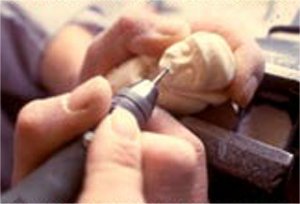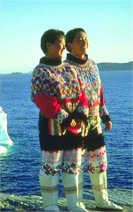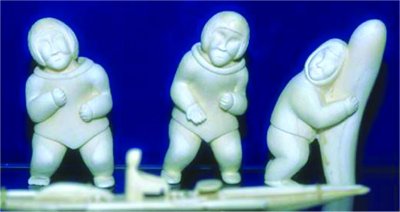Vestnorden Arts & Crafts 2004
Participating countries: |
|||






Greenland

In the old days the handicraft and art of Greenland was not seperated from the culture that created it, the Inuit hunting society. Art did not try to rise above and did not exist as an entity, only as the tools that had to be made and therefore the craftsman was a practical artist. Boats, hunting gear, tupilaks, sculptures, dolls or toys were made with the same artistry and the materials used were, skins, driftwood, bones, horns of reindeer and moscus ox and teeth of walrus and whales.
It was not until in the late nineteenth century, when Greenland┤s handicrafts became sought after by European whalers, that the craftsmen realized that the items had a value of their own, other than the practical value and started to trade them for European goods. Then craftsmanship became an occupation.
In the middle of the twentieth century the Greenlanders culture and craftmansship was waning because of European cultural influence. But in the 1970┤s there was a great awakening in cultural affairs because of rising demands of indepenence from Danmark and people looked for strength in the ancient culture. The tradional handicrafts, that were almost forgotten, were revived and people started to sew clothes of skin and make the old national costumes and to carve tupilaks, little kayaks and umiaks and dog sleighs. The traditional handicrafts are now in good health.
On the exhibition there were clothes made of fur, seal skin and moscus wool, jewelry made of reindeerhorns an narwhale teeth and carved items og stone and wood.
Participants: |
|||
| Thue Christiansen | Traditional handicrafts | ||
| Gunnar Ignathiussen | Traditional handicrafts | ||
| Marie Kielsen | Traditional handicrafts | ||
| Peter Lindhardt | Stonecarving | ||
| Saime Mathiessen | Traditional handicrafts | ||
| Jˇnas Napatoq | Masks | ||

